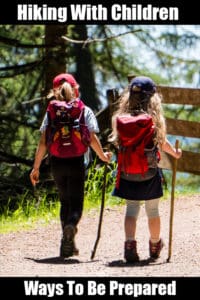
Hiking with children requires a little more planning and preparedness than hiking with adults. Before you take your kids out on the trail, be sure you have thoroughly prepared them for the experience. If you have children and love the great outdoors, one of the most exciting adventures you’ll ever have is the day you introduce your family to hiking.
PREPARING FOR THE HIKE
Before you go on a family hike, make sure every family member has proper gear, including clothing appropriate for the weather conditions, well-fitting walking shoes or hiking boots that have already been broken in (to avoid blisters), a water bottle, and suitable trail snacks.
Prepare your children to enjoy the hike by telling them about some of the exciting things you might see…a waterfall, a rushing river, tall pine trees, wild animals, unusual birds, and lovely flowers. You may want to bring along a guide to local flora and fauna to help you understand what types of flower, shrubs, trees, birds, and animals you might come across during your hike.
If your child is old enough to write, have them take a notebook or journal to write down fun things they find along the hike, what they saw, smelled and heard.
PERSONAL ELECTRONIC DEVICES: YES OR NO?
One of the main benefits of any venture out into nature is the lure of completely unplugging from our digital world with its attendant information overload. So it’s natural to want your children leave their phones and tablets at home. But you don’t want to end up 100% disconnected in case an emergency arises, so one adult should carry a fully-charged phone so you can call for help if needed.
On the other side of this argument is the fact that cell phones take wonderful pictures and videos. Your older children especially may want their phone along to capture their own photographic memories of the hike. Make this a family discussion and decide together how you want to approach the issue of unplugging before going on your hike.
Remember that many wilderness areas have poor cell phone reception or none at all, so the argument may be moot. Your phones may only be good for taking pictures and not calling for assistance.
Familiarize yourself with your selected trail prior to departure to determine if cell phone coverage is available. Many state and national parks have patrolling rangers who can offer help if needed, plus they have many breathtaking trails available for family hikes. Check local tourist guides to see what trails they recommend for families.
DEGREE OF DIFFICULTY
If you are hiking with your children, don’t chose a challenging trail with a high degree of difficulty. Even experienced adults can get into trouble on such hikes. Instead, choose an easier trail that offers lots of places to stop, rest, explore, and observe wildlife and nature along the way.
TEACHING OPPORTUNITIES
Mother Nature is a wonderful classroom, and her lessons are easy to understand and enjoy, A hike is a great way to show children nature up close while also teaching them to be good shepherds of our wild places. Over time, they will learn to appreciate the many resources nature offers to birds, insects, animals, and humans.
If you’ve been hiking for a long time, you’ll also enjoy being able to see things anew through the eyes of your child. Everything outdoors is a wonder to children…the colors on a butterfly’s wings, an eagle soaring overhead, the musical splash of water in a creek. And if you’re lucky enough to see a squirrel, rabbit, or fox run across your trail, that can become a treasured lifetime memory.
CLEANING UP AFTER YOURSELF
If you stop along the trail to enjoy a picnic lunch or snack at a scenic overlook, take the opportunity to model cleaning up after yourselves to your kids. Have them help you pick up and bag all your trash and put it in provided bins. If no trash receptacles are provided, carry your trash out of the trail area to properly dispose of once you’re back at home. Teach your children the ideal of leaving behind only footprints when they go out into nature and you’ll have the confidence of knowing they will not grow up to become litterbugs.
BUILDING SELF-RELIANCE
A child who feels comfortable interacting with nature will grow up to be an adult who treasures the wild places of this Earth. Teaching skills like making fire, foraging, identifying plants and their uses and dangers, and becoming familiar with the traits and behaviors of wild animals all help children gain self-assurance and confidence. As they mature, children raised with regular exposure to nature become more and more self-reliant and confident, able to face and solve problems with skill and discernment.
GREAT FAMILY OUTING PLUS EXERCISE!
It’s often difficult for parents to find time to attend to their own personal fitness, let alone teach such values to their children. A hike is not only a great way to have fun while deepening family bonds, but you’ll also be building stronger bones and muscles, increasing your blood flow and respiration, and burning calories, all at the same time. Hiking provides the entire family with vigorous exercise that’s so much fun you won’t even be aware you’re working out.
IN CONCLUSION
If you’re looking for a great family activity, consider taking a hike together. The entire family will enjoy discovering Mother Nature’s many secrets and surprises while getting a good work-out and spending quality family time together.
You also need to educate your children about hiking safety and what they should and shouldn’t do while out on the trail. Check out Some Safety Tips For Hiking With Kids to learn more.